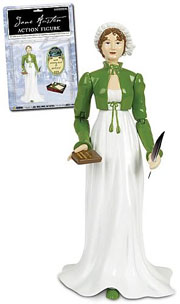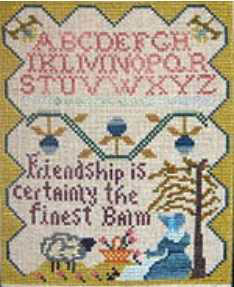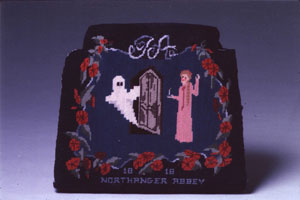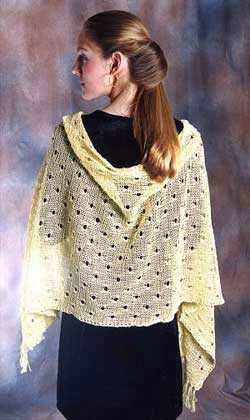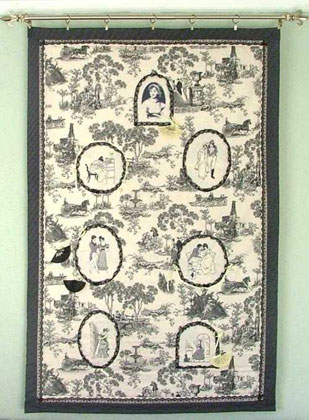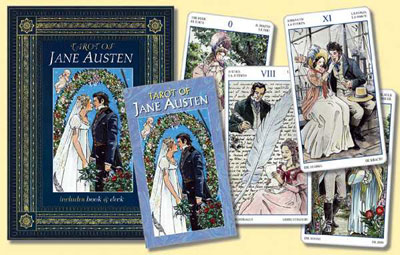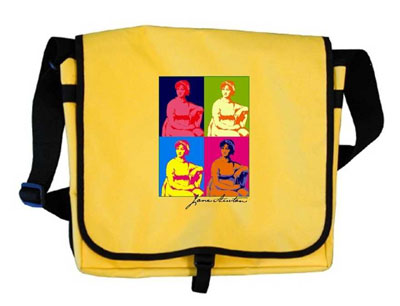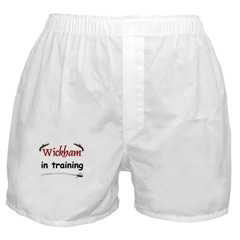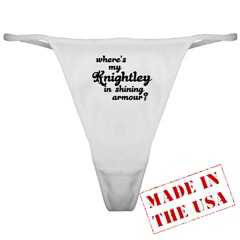|
Enthusiasts (whether of jane austen, keira knightley or colin firth) continue to churn out a relentless deluge of sequels and fan-fiction, but the Jane Austen franchise has expanded beyond mere words: there’s the stuff. We’re not just talking coffee mugs and key chains, “I ♥ Fitzwilliam” tee-shirts or “Jane is my Home Girl” bumper-stickers. Of course these items abound, and their numbers are legion. But Austenland is larger than commonplace trinkets like these: advanced consumers have moved on to items such as infants’ bibs emblazoned with Mr. Woodhouse’s imperative cry—“Gruel!”—or a clock face bearing Captain Wentworth’s plea, “Tell me not that I am too late!” It has been observed that there are now many ways to appreciate Austen beyond simply reading her works: one can tour stately houses that Austen never visited but that have recently served as movie sets, dress up in costume to re-enact scenes from the books, play Austen-trivia games, or create funny YouTube videos by over-dubbing a nature film about lions with the sound-track of the trailer to the 2005 Pride & Prejudice (a very new take on Pride and Prejudice). To these activities must be added the purchase and display of Austen artifacts: that is, the consumption of Austen.
Figure 1—The Jane Austen Action Figure It is ironic that an author who used a character’s
obsession with material items as a sure sign of snobbery, boorishness, or moral
deficiency should now have so many material goods associated with her.
Claudia Johnson observes that “when objects are made to stand out with
specificity in Austen’s novels, something is wrong” (222). Austen
invites us both to laugh at and to scorn silly Harriet’s mooning over Mr.
Elton’s cast-off pencil-stub, Mrs. Elton’s bragging about her sister’s
barouche, or Mr. Robert Ferrars’s wasting both his time and Elinor’s over
choosing the most desirable tooth-pick holder. Frank Churchill’s
inappropriate and embarrassing gift of the expensive piano shows his
thoughtlessness and immaturity; Mr. Knightley’s refusal to use his carriage—a
symbol of status—save to transport the Bates ladies shows his practical and
gentlemanly character. Austen would undoubtedly make sport of us with our
modern obsession for the memorabilia associated with her, but to understand the
industry that has grown up around her, we must first understand the nature of
fannishness and the ways in which fans, by investing economic capital in
consuming artifacts surrounding the object of their fandom, also express facets
of their own personalities. For more than one hundred years, Austen has
inspired, as Deidre Lynch notes, “the devotion and fantasies of personal
access that are the hallmarks of the fan.”
She argues that even the name “Janeites,” coined around 1894, suggests a
personal connection to the author that no other literary giant possesses:
Shakespeare-lovers don’t call themselves Willies,
for example (Lynch 111, 112). The word “fan” is not often applied to
admirers of high culture: “fans” are popularly believed to be pimply
adolescents who speak Elvish or Klingon and who spend their days asleep and
their nights playing games on the internet. By contrast, Austen readers
are more used to describing themselves using class-elevating, pats-on-the-back
words such as “cognoscenti,” “buffs,” or “aficionados.” It
remains unusual to apply a group nickname like “Janeites” to any sort of
middle- or high-brow activities at all (Pearson 98). But Janeites in fact exhibit the same
characteristics of fandom recognized more readily in the followers of Star Trek. By definition, fans
typically are interested in even minor details of the object(s) of their fandom
and spend significant portions of their time and energy involved with their
interest; members of a fandom freely associate with one another, often attending
fan conventions; some fans write fan fiction (fanfic) based in the universe or
around the characters in their chosen fandom; some fans dress in costumes (cosplay)
or recite lines of dialogue either out of context or as part of a group
reenactment. In some fandoms such activities are sometimes known as “fanac,”
an abbreviated form of the phrase “fan activity,” but one that also brings
to mind the word “fanatic.” Roberta Pearson argues that fans “incorporate
the[se] cultural texts as part of their self-identity, often going on to build
social networks on the basis of shared fandoms” (102). She argues that,
while they would not call themselves “fans,” lovers of Bach or Shakespeare
are just as passionate and “fannish” as the more familiar Trekkies and even
suggests that there is a “fannish disposition,” in which people disposed to
this type of activity engage in multiple or serial fandoms (Pearson 101). Deborah Kaplan writes that, from the author’s
death until recently, Austen’s novels were considered to be highbrow
literature that appealed to a select few only, and that admiration of Austen
even conveyed to the fan an aura of cultural superiority. Today, the films
have brought Austen’s novels to many viewers around the world, and academics
are increasingly examining how Austen is received. Kaplan suggests that
this is a particularly rich moment in Austen scholarship, that “Austenmania
has prompted a renewed awareness of the power of audiences to determine the
status and meaning of literary works, to construct, in this case, very different
Austens” (4-5). Certainly the merchandise purchasable in the Austen
franchise amply demonstrates the very different Austens that fans can create. The acquisition and display of Austen artifacts
work on several different levels, sometimes simultaneously. To begin with,
tee-shirts or bumper-stickers can work as tribal markers, rather like the
Masonic handshake or gang colors and tattoos: they enable two previously
unacquainted Austen fans to identify each other. Some of the items or
slogans also illustrate various degrees of “getting it,” even among
fans: the “My Other Car is a Barouche” bumper-sticker, for example,
implies that the owner knows her barouche from her high-perch phaeton while it
also separates her from the non-fans or, perhaps even more important, from those
fans who only watch the movies and rarely read the books. For even within
the Austen fandom there is a great divide, very apparent in the fanfic and
paraliterature, between those fans who are primarily inspired by Messrs. Firth
and Macfadyen and those who, while enjoying the movies, focus principally on the
books and claim, justly or not, some intellectual superiority over the first
group. Beyond this basic purpose of identifying the fan, the artifacts can be divided into three categories, each representing a varying reception of Austen or a different positioning among her fan base. The first group might be called “evocative” and includes the items that evoke either the author or the Regency period in general. The second major category of Austen artifacts consists of the crafts and games created largely by individual fans and marketed principally, though not exclusively, through the internet. The third category of Austen artifacts embraces the hip and ironic, items that create an image of Austen directly opposed to the traditional romantic Austen. Lavender
and Old Lace: Evocative Artifacts Claudia Johnson has examined the Austen “treasures” found at the museum at Chawton, treasures that range from a lock of Jane Austen’s hair, to her music books and lace collar, to other items that Austen never actually saw or touched: the 1810 piano “similar” to one that she owned or the dining-room table that was never actually at Chawton during Austen’s residence but was in use at the Great House when her brother Edward was alive. She argues that these treasures “call out for our respect either because they shared the same space Austen occupied, albeit at different times, or because they shared the same time with Jane Austen, albeit in different places” (Johnson 219). To this observation we must add the items currently for sale that Austen never saw but that evoke her life and times for romantically-oriented fans.
Figure
2—Mansfield Park Sampler These evocative items—the lavender-scented “Mrs. Darcy” soap, the note cards, the tea, the lace fans and pearl necklaces sold by the Bath Centre or by various chapters of JASNA—clearly act as talismans of the fan’s love for Austen and her wish to invoke the spirit of the author or to enable the fan to live as the author might have: Jane must have used a quill pen to write with, this fan thinks, so I will too. These romantic items also serve as a marker of actual or desired social class as they evoke an imagined pretty, genteel, upper-class English life. The ownership and display of these items sends the message that “I am a sweet, romantic, pretty, prim, proper, innocent of world affairs/issues, probably WASP-y Anglophile.” It is unlikely that the fan who owns only the romantic artifacts wears a tee-shirt, but if she did, I suspect that it would be the one with the wistful statement “I’m an Elizabeth in a Darcy-less World.” Powered by the lovely images from the movies as well as the long-held aura of respectability, the Austen name can serve as a marque for country-house gentility, to the extent that she can be invoked to sell products that are unrelated to her. Take wallpaper, for instance. Austen never wrote about wallpaper, but the Sanderson Company of Great Britain offers “The Pemberley Collection” of eight coordinated wallpapers ranging from the “magnificent” design Peony Tree to the “smart and versatile stripe” Netherfield Paper: designs to suit “any interior space from townhouse to country cottage,” according to the company’s web site. The company also offers fabrics in “Tilney” (a large, open check), “Eliza” (small check), and “Catherine” (big leaf)—all in a variety of color-ways. While neither the patterns nor the colors seem at all “Austen-ish” to this fan, the name is certainly being used to evoke an aura of romantic gentility. Finally, these pretty artifacts appeal to the fan who wants to create a sense of historicity—not the history that includes chamber pots and muddy roads, but the one that features tight pantaloons and tasseled Hessians, low-cut silken gowns and elegant assemblies. This fan might be attracted to the Bath Centre’s Georgian Lace Parasol (“perfect for summer weddings”) or the sleeveless, high-necked Georgian Nightgown, neither of which look particularly “Georgian” to this author. This is “history as it should have been,” as the folks at the Society for Creative Anachronism say. Indeed, the popular bumper-sticker “I’d Rather be Reading Jane Austen” suggests that some fans feel a certain anomie with the present and would like to escape to a prettier and more genteel past. In this they apparently differ slightly from fans of Dickens (Chuckies?) who take themselves and their offspring to Dickens World, a theme park that opened in May 2007 in Kent. There these fans can experience some of the darker aspects of Victorian existence: the Great Expectations Log Flume ride through smelly sewers, the Haunted House of Ebenezer Scrooge, and scary encounters with Fagin and his gang of pickpockets. Interacting
with Austen: Crafts and Games Exhibiting creativity in crafting is clearly an important way to consume Austen, and many fans use their craft skills to express their passion for their favorite author. Thus, for example, New York City JASNA-member Gene Gill working with artist Isabelle English has devised six canvas needlework patterns, each commemorating a novel and collectively called “Jane in Stitches.”
Figure
3—Jane in Stitches: Northanger Abbey Maine-based stitcher Tanya Marie Anderson (“The Sampler Girl”) has created six Austen-inspired cross-stitch samplers sold through a distributor in the States and, most recently, through The Jane Austen Centre in Bath. (See Figure 2.) Many crafter-fans are engaging in a thoughtful and informed incorporation of their crafts with Austen’s characters; that is, they are creating three-dimensional theses on the nature of characterization. Beader Tammy Powley posts patterns on the internet so that you may bead your own Austen-inspired earrings: she writes that her Mansfield Park earrings, for example, feature pearls, popularly believed to symbolize purity, and thus Fanny’s purity of heart, while her Persuasion earrings feature jet crystals, “suitable for a mature heroine.” Along these lines, one internet-based chat-and-crafts club, called “Knit the Classics,” reads one classic a month as members compete to create an original craft inspired by the novel. In May 2007, the group read Mansfield Park, and members created shawls and wrist-warmers for Fanny and a miser’s purse for Mrs. Norris. Member Lydia won the contest with her “Fanny Pack,” which she described as a “non-dorky” fabric pack embroidered with an anchor to evoke thoughts of William; it’s a pack that even frail Fanny could wear without undue exertion.
Figure 4—The
“Fanny Pack” by Lydia More handmade work can be seen at the web site “Etsy,” an on-line store for artists and crafters; it featured, as of this writing, sixty-one original Austen-inspired items such as earrings, Regency Barbie doll gowns, one-of-a-kind collages, “altered” business-card cases with Austen sayings on them, and “Dreaming of Darcy” paintings. Knitting fans can consume Austen in several ways, from knitting any item they choose using yarn named after an Austen character to knitting a garment that such a character might wear. The company Yarn Love produces base yarns named after Elizabeth Bennet (a custom-spun blend of superfine merino wool, bamboo, and silk) and Marianne Dashwood (a washable 100% merino); the purchaser’s choice of base yarn is then hand-dyed to order. One of the owners informed me that they wanted to evoke a romantic feel for their company, so they picked heroines from history and literature after whom to name their base yarns: their other yarns are named for Joan of Arc, Juliet, and Scarlett O’Hara (Sharon). Moving from yarns to patterns, Stefanie Japel’s book Fitted Knits offers patterns for an “Elizabeth Bennet Cabled Cardigan” as well as a knitted shrug suitable for either Jane Bennet or Caroline Bingley. The Chic Knits web site also offers the pattern for a spencer-like lace shrug named after Miss Dashwood while St. Seraphina Knits offers both the “Pemberley Shawl” and the “Eliza Bennet Shawl.” For experienced machine-embroiderers, Advanced Embroidery Designs offers a free pattern on the internet for a wall-hanging that, with nineteenth-century toile background designs and embroidered insets of some of the Brock illustrations, pays homage to Austen and her novels.
The borderline of authenticity in combining fandom and crafting can be highly permeable: it can incorporate both the act of quilting, as undertaken by Jane, Cassandra, and their mother (and countless other women in England and America) as well as the attempt to replicate the specific object (the so-called “Chawton quilt”) that those specific women sewed. Thus, quilters used to be able to consume Austen by working with cloth offered by British fabric-manufacturer Makower, which until recently sold a set of fabrics with names like Chawton, Winchester, Regency, Emma, and Wickham in a variety of color-ways. A Makower spokesperson informed me that some of these patterns were directly inspired by the quilt sewn by the Austen women that is now displayed at Chawton; others were inspired by other Regency-period fabrics (Smith). A knowledgeable fan could thus with some effort reconstruct the Chawton quilt, a complicated patchwork using sixty-four different fabrics. But Makower also used to offer a free “Jane Austen Quilt” pattern (still visible on the internet), using the Austen line of fabrics, but with a very modern-looking pattern. Here one has to wonder what exactly is being invoked: if one makes a quilt in any modern pattern and color but using fabrics similar to those that Jane might have purchased, does that choice of fabric alone make it an Austen quilt? This possibility pushes “fannishness” to a new extreme. Game fans as well as crafters also have a way to consume Austen. Julienne Gehrer, board game designer and Life Member of JASNA (the Kansas City chapter), created and publishes the Pride and Prejudice board game. The object of play is to take one of the four couples from the novel and maneuver the characters separately or together through town and country en route to the parish church. Gehrer says that the game made its market debut in September of 2002 and sold 2,000 copies by the end of October; she had to reprint it quickly to support Christmas sales and to date has sold nearly 8,000 copies to fans around the world (Gehrer). And for Tarot enthusiasts who want some interesting insight into the novels as well as into the perplexing questions that vex them, there is The Tarot of Jane Austen, devised by Tarot-master Diane Wilkes, illustrated by Lola Airaghi, and distributed by Lo Scarabeo, an Italian firm that creates and sells playing and divination cards. The Tarot of Jane Austen is their only Tarot deck devoted to an author.
Figure 7—The Tarot of Jane Austen Austen Rocks: Hip and Ironic Artifacts These ironic and humorous artifacts, such as the action figure or the underwear described below, make a statement about the displayer: “Hey, I’m a freaky Janeite, but I’m cool too!” Displayers of these items enjoy the contrast between the public perception that Austen is all about love and pretty dresses and the hip and ironic statements that the artifacts actually convey.
Figure 8—The Jane Austen Pop Art Messenger Bag The fan who carries the Republic of Pemberley’s Warhol-inspired Pop Art Messenger Bag or wears the tee-shirt with the slogan “Someday my There are numerous Austen artifacts that fall into this hip, ironic category, starting with the rather dissipated-looking magnetized Austen finger puppet from The Unemployed Philosophers Guild—“witty gifts for sophisticated, funny people.” “Host a tiny tea party with this Austen finger puppet!” urges the company’s marketing blurb.
Figure 9—The Jane Austen Finger Puppet “[I]n your finger puppet collection, her biting social satire will reveal the underlying truths of her finger puppet society.” Along with this magnet, fans can display the Jane Austen Action Figure, which comes with her famous writing desk and a removable quill pen. (See Figure 1.) David Wahl, public relations manager for Accoutrements, the manufacturer of this figurine as well as other outré items, such as the remote-controlled, hopping, yodeling lederhosen, informed me that the company started offering the figurine in June of 2005, as one of five authors represented in the forty-one-figure collection. It is the best-selling of any of the company’s author figures (the others are Dickens, Shakespeare, Poe, and Wilde) although it doesn’t sell as well as the more popular Librarian, Jesus, or Lunch Lady Action Figures. “The reason it sells so well is not only that there are so many Jane Austen fans, but they are also organized,” says Mr. Wahl. “As soon as the figure went up for sale, the network of Austen appreciators got the word out.” CaféPress, a print-on-demand internet store, sells many fan-created Austen artifacts that display an ironic sensibility. CaféPress allows the seller/designer to print her designs on any of eighty different items (mugs, magnets, mouse-pads, etc). You can purchase items with a “What Would Jane Do?” slogan that pokes sly fun at the “What Would Jesus Do?” saying, or tee-shirts emblazoned “Team Brandon” or “Team Tilney” in reference to the “Team Brad” or “Team Jen” shirts worn by their respective fans during the Pitt/Aniston break-up. The combination of some of these items with the Austen quote or reference is risible in and of itself. One can imagine, for example, the froideur that falls over the scene when two Austen fans engaging in their first amatory encounter find that he is wearing boxers that proclaim him “Wickham in training” while she is wearing the thong underwear adorned with the phrase “Where’s my Knightley in shining armor?”
While
each of these sayings is cute and clever, the real amusement, perhaps, comes not so much from the slogans on the clothes but from the notion of underwear and sex in association with the popular image of Austen as prudish, chaste and “Victorian” (though she of course belonged to an earlier and earthier period).
Given that so many of these Austen artifacts are produced by fans or fan groups such as the various chapters of JASNA themselves, it is not surprising that the English-speaking countries of the U.S., Great Britain, and Australia are the principal producers; what is not known is where most purchasers hail from. Is the wry “Jane 2008” tee-shirt (referring to the coming U.S. presidential election) as funny in Bulgaria as it is in Boston? Doubtful. But the crafts, the games, and the genteel items would certainly appeal to a broader, non-American audience. Austen is big business now as shown by the continuous production of films and the plethora of web-based Austen fanfic and erotica and print-based Austen paraliterature. So far, with the exception of the wallpaper, fabric, and yarn, most of the Austen-inspired physical objects are created and sold by individual fans or fan groups. It is unlikely that General Motors will offer a Jane Austen sedan (“As luxurious as Mr. Suckling’s barouche!”) or that Campbell’s will produce a line of Mr. Woodhouse-approved gruels—cars and soup being very much mass-market items—but it is not inconceivable that some firm might follow the wallpaper company’s lead and eventually use the Austen name to sell, for example, up-market reproduction Regency-era furniture. Roberta Pearson has observed that “[c]onsumption in the form of collecting is a key element of the popular stereotype of the nerdy, needs-to-get-a-life fan” (Pearson 104), and the range of Austen items available and the passion of their creators and purchasers prove that high-culture Janeites and popular-culture Trekkies and Elves share the same fannish affect. What is not understood, however, is the average economic and cultural profile of different fan-bases. It is easy to imagine—though perhaps not wholly true—that Janeites are ladies living in the drawing room while Trekkies are teenage boys living in the basement. Jane Austen, with 61 handmade items to her name offered on the internet store Etsy, trumps Star Trek (31), Sherlock Holmes (24), and The Lord of the Rings (37). This makes sense, one thinks: many Janeites are women; many women are crafters; therefore many Janeites make stuff. But all of these fandoms fall miserably behind the 459 items for sale under the Harry Potter name. What room do Potterheads inhabit? When we examine the number of fan artifacts available on two other major internet marketplaces, the picture becomes even more confused. As of this writing, CaféPress sells 914 different Austen images on 5,330 items, comparing favorably, image-wise, to Dickens’s 476 images on 9,220 items, but falling short, product-wise, of J. K. Rowlings’s 831 images on 17,600 items. But even the Rowlings fandom pales compared to Star Trek, whose fans sell 2,520 images on 43,000 items. On Ebay, Austen sells much more weakly: only 380 items for sale as of this writing, compared to more than 10,000 each for Harry Potter and Star Trek, approximately 5,600 for The Lord of the Rings, and 2,143 for Dickens. It is beyond the scope of this paper to examine the types of artifacts sold by and to each fandom, but it is clear that there are differences in the relative desires as well as the relative economic abilities of different fans to consume objects related to their obsession. The range of Austen artifacts available in the market today supports many different ways of interacting with the author, her characters and even her era. The romantic articles that evoke a Regency period “as it should have been,” the crafts that pay homage to her or that explore some aspect of her characters, the ironic items that express a counter-image of Austen—all of these are ways in which fans can actively shape the reception of their own particular Austen as well as put their own interests and personalities on display by reference to her. WORKS
CITED Gehrer, Julienne. Email to author. 7 Aug. 2007. Johnson, Claudia.
“Jane Austen’s Relics and the Treasures of the East Room.” Persuasions 28 (2007): 217-29. Kaplan, Deborah.
“The Pride of Austen Critics: A Prejudice?” The Chronicle Review 11 Mar. 2005: B10-12. Lynch, Deidre Shauna.
“Cult of Jane Austen.” Jane Austen
in Context. Ed. Janet Todd. Cambridge: CUP, 2005. 111-19. Pearson, Roberta.
“Bachies, Bardies, Trekkies, and Sherlockians.” Fandom: Identities and Communities in a Mediated World. Ed.
Jonathan Gray et al. New York: NYU P, 2007. 98-109. Sharon. Email to
author. 23 Jan. 2008. Smith, Jayne.
Email to author. 8 Aug. 2007. Wahl, David. Email to author. 20 July 2007. |


